Following the Digital Clues: Mystery Genre Spotlight

The world of mystery is ever-popular and ever-evolving. Whether a classic “whodunit,” a cozy, a police procedural, or something in between, crime fiction still draws readers nationwide. In a brief survey of 232 public libraries conducted by LJ, 55% of respondents reported that mystery continues to be the most popular genre in terms of circulation. The survey also found that in print fiction collections, 24.1% of materials are mysteries.
What is new this year is that mystery titles make up over 20% of library ebook collections. And like their print counterparts, the highest circulating subgenres in mystery ebooks are police procedurals and cozies. However, 57% of the survey respondents do not purchase e-original mysteries (perhaps owing to a lack of review coverage and issues of discovery?); chief e-mystery purchase influencers are high-demand titles, user requests, and cost.
Still, the percentage of digital mysteries in library collections is certainly going to grow as libraries boost their ebook budgets and publishers gradually lower their resistance to library sales. Barbara Hoffert’s recent materials buying survey reveals that ebooks now take up 6% of libraries’ materials budgets, up from 1% in 2009. And it is certainly no fluke that Macmillan chose its Minotaur Books crime imprint to launch its two-year ebook library lending pilot with OverDrive, 3M, and Baker & Taylor, which went live March 1.
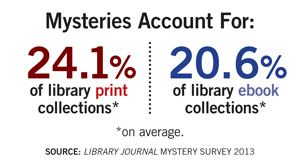 The future is now
The future is now
“Ebooks aren’t the future of mystery, they’re the present,” declares Soho Press publisher Bronwen Hruska. In 2012, ebooks made up 67% of the sales of her Soho Crime imprint. But Hruska is not predicting the demise of physical books. “There really is room for both, and while we’re selling slightly fewer physical books in the genre, ebook sales have made up for those lost sales and added many more.”
Digital sales are also driving about 50%–65% of all Minotaur sales. Despite the restrictions imposed in Macmillan’s ebook lending pilot (only 1,200 backlist titles will be available on a one-copy/one-user lending model, and libraries will be able to circulate each copy for 24 months, or 52 loans, whichever comes first), Minotaur hopes this venture will enhance its digital publishing viability.
“Our goal is to understand the lending marketplace and see what, if any, impact it might have on our retail sales,” explains Minotaur publisher Andrew Martin. “It will take some time to evaluate this, which is why the pilot is two years long. Minotaur’s list of mystery and crime fiction is an especially strong category in physical library sales, and we anticipate a high level of purchasing for our electronic editions. We hope the program introduces our books to new readers and generates some incremental sales for Macmillan and our authors.”
For Permanent Press copublisher Martin Shepard, ebook sales are the “extra gravy” as his hardcover sales have not changed much. “Mystery ebooks represent 15%–25% of sales, while with our straight novels the percentage of ebook sales are under ten percent.” Still, he noted one large exception when Leonard Rosen’s debut thriller, All Cry Chaos, was picked as a Kindle Book of the Day and the press sold 7,000 electronic copies and 4,000 print.
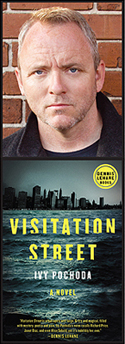 Q&A with
Q&A withDennis Lehane: Publisher’s-Eye View
In October 2011, Dennis Lehane added “publisher” to his impressive list of credits (best-selling and award-winning author, screenwriter, producer, occasional bit actor) when HarperCollins introduced Dennis Lehane Books. Under Lehane’s editorial eye, this new imprint focuses on dark, literary fiction. It launched last year with Attica Locke’s acclaimed thriller The Cutting Season and this July releases its second title, Ivy Pochoda’s Visitation Street, a literary mystery about the disappearance of a young girl from Red Hook, Brooklyn. By the way, Lehane’s Live by Night, the second novel in his historical trilogy about a Boston family of Irish cops, has been nominated for a 2013 Edgar Award for Best Novel, and news reports indicate that Ben Affleck is set to direct and star in the film adaptation.
From previous reports, you were approached by HarperCollins to create this publishing imprint. What do you feel it will add to the field?
DL: Beats me. I never felt I was charged with adding to the publishing field, just picking out cool books and hoping my name would help boost their profile a bit.
What kinds of work will you be looking for? Are you planning to tailor toward any particular genre?
I’m clearly a crime fiction writer and clearly an urban novelist, so my tastes tend to run toward novels in which violence is a central subject and urban concerns play a part. But the latter didn’t come into play with my first pick, The Cutting Season, though my next, Visitation Street, is about violence and its effects (among many other things) in the Red Hook section of Brooklyn. At the end of the day, all I want is depth—of character, of language, of insight, of structure. I don’t care if it’s set in rural Alaska and doesn’t have a drop of blood in it as long as it’s good.
The lines of mystery and literary fiction are becoming more blurred (as are many genres). Do you think this is good for readers?
I’m not sure how it could be bad. “Genre” pertains to exactly two entities—people who write to it and marketing folks at the publishing house. If you read Clockers, say, or The Lovely Bones and describe them as “crime novels” because, uh, they have crimes in them, then you’re limited in a cranial sense. You have a need to label and box things into compartments and you’re probably quite predictable as a conversationalist. If, however, you say, “I want a book to be true and fearless and written with grace and I don’t really give a shit what category it falls into beyond that,” then I’d like to buy you a drink and ask your opinion on any multitude of things.
Do you believe Visitation Street will appeal to mystery readers?
I don’t know what a “mystery reader” is. Visitation Street has a wonderfully eerie and intriguing premise that drives the book from the end of the first chapter on, but it’s the evocation of place, the spot-on rendering of a diverse cast of characters, and the poetic pitch of the writing that elevates the book into the sphere of literature. If I just want a plot, I can watch a movie. If i just want language, I’ll read poems. A great novel embraces both those things and so much more.
New publishing models
Digital publishing creates opportunities to release and market books in new ways. Andy Bartlett, a senior editor at Amazon’s Thomas & Mercer crime fiction imprint, cites Kindle Serials, which enables readers to enjoy new titles like Andrew Peterson’s Option To Kill and Dani Amore’s The Circuit Rider in electronic episodes delivered to their Kindles. “This type of serialized reading experience, which often includes cliffhangers at the end of each episode, works particularly well for mysteries and thrillers.” First serialized last fall, the completed titles were released in print and ebook formats this past January and February, respectively.
HarperCollins and its William Morrow imprint have found e-originals to be successful in satisfying their authors’ fans with quickly published content, while also helping set up future publications. “Many of the novellas, and even full-length e-originals, that we publish tie in to specific characters in an ongoing series,” says HarperCollins’s senior director of marketing Shawn Nicholls. “In the case of James Rollins last summer, we published Tracker, which helped introduce a new [‘Sigma Force’] character.”
Nicholls also points out that e-originals in this genre are very effective in gaining new readers in advance of a new publication. “In the case of Matt Hilton, a house author who is preparing to publish his fifth novel featuring ex–military operative Joe Hunter for only 99¢, we set a goal to reach fans of comparable authors with something short and fun.”
Nicholls notes that the speed at which a publisher can release a digital title enables that house to tie into what’s hot in the marketplace to an incredible advantage. “All of our e-originals are as aggressively marketed as our frontlist print books. The combination of marketing, lower price point, and word of mouth—after readers whip through them—has led to amazing success in this genre.”
Digital start-ups
The jump in digital sales and the lower start-up costs have inspired other presses to bypass the traditional print route. One such house is Stockholm Text Publishing. Founded in 2011 and based in the Swedish capital, the company aims to publish in English the best of current Scandinavian fiction and nonfiction. Noting mystery’s constant popularity, publisher Claes Ericson sees even greater interest among ebook readers. Of the 15 titles his company released in 2012, the majority were crime fiction. “Mystery is one of few genres where there is a great appetite for foreign literature, not least [of which are] Swedish titles.”
Despite its digital-first business model, Stockholm Text stresses the importance of allowing readers to discover books in whatever format they prefer. Its digital releases are supported by print-on-demand trade paperback editions, and best sellers are distributed to major U.S. booksellers and libraries through Perseus Books Group and Consortium.
High on Stockholm Text’s 2013 list are new series entries by its two most popular authors whose novels are also best sellers in Europe. Released as a February ebook (which received a starred LJ review, Xpress Reviews), Mari Jungstedt’s Killer’s Art features Supt. Anders Knutas, whose probe into a local art dealer’s death leads to a sweeping mystery of high art crimes, drugs, and prostitution. The print edition will be released in October, and thriller master Harlan Coben has praised Jungstedt as “one of the best writers of Scandinavian crime fiction.” Stockholm Text’s lead fall title, Anna Jansson’s Strange Bird, will be published in simultaneous digital and print editions this September. Nominated for the Glass Key Award for the best Scandinavian crime novel and now translated for the first time into English, this dark thriller twists the fear of a bird-flu pandemic into the murder of a local nurse, and Det. Maria Wern must mitigate the locals’ growing panic while she hunts for the killer.
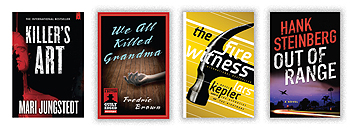 Launched in June 2010, Harlequin’s digital imprint Carina Press may be best known for publishing romances, but its releases span other genres, including mysteries. One of Carina’s most popular mystery authors, Jean Harrington, returns in April with Killer Kitchens, the third installment in her cozy “Murders by Design” series. In May comes S.G. Wong’s debut, Die on Your Feet, a most unusual paranormal noir mystery set in 1934 Crescent City, an alternative version of Los Angeles as colonized by the Chinese.
Launched in June 2010, Harlequin’s digital imprint Carina Press may be best known for publishing romances, but its releases span other genres, including mysteries. One of Carina’s most popular mystery authors, Jean Harrington, returns in April with Killer Kitchens, the third installment in her cozy “Murders by Design” series. In May comes S.G. Wong’s debut, Die on Your Feet, a most unusual paranormal noir mystery set in 1934 Crescent City, an alternative version of Los Angeles as colonized by the Chinese.
Like other publishers, Carina sees digital crime fiction as a growth area that can also support print endeavors. With digital reading, especially on tablets, on the rise, Carina executive editor Angela James believes that mystery readers will be looking for more digital content.
“By acquiring original fiction in the mystery genre, we can support Harlequin’s reader subscription Direct to Consumer Print World Wide Mystery Program with original content,” says James. Subscribers to Harlequin’s Reader Service Program can sign up to receive a certain number of mystery titles per month. This program puts between six to ten Carina mysteries into print per year, and James expects to put more titles in print this summer.
Even the Big Six go digital
Dutton, an imprint of Penguin Group (USA), publishes such best-selling mystery and suspense authors as Harlan Coben, Linda Fairstein, and Elizabeth George. But last summer it revived its pulpy Guilt Edged Mysteries line (1946–56), home to Mickey Spillane’s Mike Hammer novels, as a digital-only imprint dedicated to releasing hard-boiled crime short stories and novellas. Ben Sevier, Dutton vice president and editor in chief of the new venture, explains that going digital allows him to take more risks with new writers than is possible through the traditional publishing process. “The books stay available on the digital ‘bookshelf’ presumably forever,” he notes. “The downside can be discoverability in an increasingly crowded digital marketplace, which is a significant challenge.”
The inaugural 2012 list included Murder in Mumbai, a debut novella by NPR news editor Krishnadev Calamur, and Skin, a Mike Hammer adventure coauthored by Spillane and Max Allan Collins. This July, Guilt Edged Mysteries will digitally reissue a classic title from the original line, Fredric Brown’s We All Killed Grandma (1953). Brown may not be remembered today, but noir icon Spillane once called Brown his favorite writer of all time. “Fredric Brown is an incredible author to have had in the original Dutton Guilt Edged canon, and seemed like the perfect choice for a reissue in the digital age,” says Dutton associate editor Jessica Renheim. “We All Killed Grandma is an entertaining mystery that we hope will be a gateway for readers into noir, past, present, and future.”
Last fall Random House also jumped into the digital-only waters with its announced launch of four genre fiction ebook imprints: Hydra (sf, fantasy, and horror); Alibi (mystery and suspense); Loveswept (romance and women’s fiction); and Flirt (“new adult”). “We have two goals at Alibi,” explains Random House VP and digital publishing director Allison R. Dobson. “The first, of course, is to bring great mystery, thriller, and suspense titles to readers. And the second is to be the place to launch and grow the best new talent out there and connect them directly with the fans who are looking for them.” Dobson is excited about the number of submissions Alibi has received and already acquired. The imprint’s debut list is expected to launch this fall.
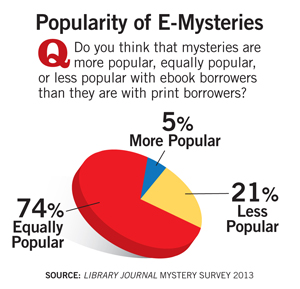 Random House did hit a recent speed bump when author John Scalzi and the Science Fiction Writers of America (SFWA), for whom Scalzi is the current president, criticized the terms of the new imprints’ contracts and initially refused to accept for membership authors published by those imprints. Now authors can either choose the original profit-sharing model (which offered no advance) or the more traditional advance with royalties.
Random House did hit a recent speed bump when author John Scalzi and the Science Fiction Writers of America (SFWA), for whom Scalzi is the current president, criticized the terms of the new imprints’ contracts and initially refused to accept for membership authors published by those imprints. Now authors can either choose the original profit-sharing model (which offered no advance) or the more traditional advance with royalties.
Back in the print world
While many publishers are releasing more mysteries for commercial reasons, other houses are discovering that the genre is attracting high-caliber writers. Founded in 1978, Permanent Press is noted for its literary titles. Yet it is increasingly publishing more crime fiction.
“What is different, for us, is that in 2012 and 2013 a bit more than half of the 30 titles (16 novels in 2012 and 14 in 2013)—17 in all—are mysteries: up from roughly 20%–25% from previous years,” explains copublisher Shepard. “Our criteria are not to pick mysteries per se but artfully written titles, and it seems that more quality fiction is coming to us in the form of mysteries.”
And those titles are winning awards. Leonard Rosen’s acclaimed debut international thriller All Cry Chaos, which introduced Insp. Henri Poincaré, was an Edgar Award finalist and Macavity Award winner in 2011. Coming in September is Rosen’s The Tenth Witness, a prequel that reveals how Poincaré joined Interpol. Shepard acknowledges that mysteries do sell better than other novels. “But this is a bonus, not a pursuit.”
As the mystery genre bleeds into other areas, these new titles represent the essence of storytelling. And who knows more about great storytelling then Dennis Lehane? Two years ago HarperCollins tapped the best-selling author of Mystic River [see Q&A, above] to head his own eponymous line that will acquire literary fiction with a “dark, urban edge.” Dennis Lehane Books’ first selection, Attica Locke’s The Cutting Season (2012), was praised by LJ as “a layered and nuanced mystery wrapped in social conscience.” Next up in July is Ivy Pochoda’s Visitation Street, a promising second novel about the disappearance of a teenage girl and its impact on a Brooklyn community.
Standing out from the crowd
Of course not every writer is lucky enough to have the imprimatur of a best-selling author to help steer their work into a crowded marketplace. First novels especially face a difficult path in publishing. How many times can the same set of tropes be introduced using new characters? “There are almost no completely ‘new stories,’ ” muses Thomas & Mercer’s Bartlett. “People like some sense of the familiar, and it’s a true measure of a novelist’s creativity when he or she molds a crime or a narrowly averted disaster into something energized and magnetic.”
Is there really any tried-and-true way for new authors to attract attention in the genre crowd? In many cases, a fresh voice and superlative talent will help a book stand out. But an author’s background can also lend weight to the writing. Screenwriter Gregory Widen brings his cinematic roots (Highlander; Backdraft) to the print medium with his debut thriller, Blood Makes Noise (Thomas & Mercer, Apr.), which revolves around the bizarre true story of the mysterious disappearance in 1955—and reappearance in 1971—of the embalmed corpse of legendary Argentine First Lady Eva “Evita” Peron.
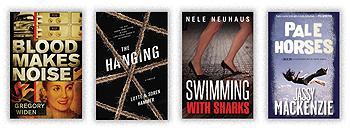 An author’s day job can easily cross over to the page. Veteran overseas reporter and Pulitzer Prize nominee Gwen Florio makes her debut this fall with Montana (Permanent, Oct.). The novel introduces foreign correspondent Lola Wicks who finds her R&R visit to Montana disrupted by her friend’s murder and tensions between town locals and the nearby Blackfeet Nation reservation. Permanent’s publisher Shepard calls Florio a major acquisition for his company.
An author’s day job can easily cross over to the page. Veteran overseas reporter and Pulitzer Prize nominee Gwen Florio makes her debut this fall with Montana (Permanent, Oct.). The novel introduces foreign correspondent Lola Wicks who finds her R&R visit to Montana disrupted by her friend’s murder and tensions between town locals and the nearby Blackfeet Nation reservation. Permanent’s publisher Shepard calls Florio a major acquisition for his company.
And Hank Steinberg transfers his experience as creator of the Emmy Award–winning television series Without a Trace into his first thriller, Out of Range (Morrow, Jun.). Reporter Charlie Davis and his family are enjoying a trip to Disneyland, until his pregnant wife, Julie, disappears. A twisted tale of secrets follows that will keep readers guessing. No wonder this title was highlighted in last year’s LJ Day of Dialog Editors’ Picks panel. Paramount has already bought film rights, and Morrow has scheduled a 100,000-copy first printing.
Global waters are still hot
The international crime fiction wave continues to show no signs of dissipating. “Crime enthusiasts have discovered a global crime scene out there with a lot more to offer than a simple whodunit,” explains Soho publisher Hruska. “And once you’ve ripped off the blinders, it’s pretty hard to put them back on.” While Hruska credits the Stieg Larsson phenomenon for expanding readership, her own company has been publishing international crime mysteries and thrillers since 1991.
High on Soho Crime’s list this spring are Timothy Williams’s Another Sun (Apr.) and Fuminori Nakamura’s Evil and the Mask (Jun.). Williams, the Crime Writers Association Grand Master, returns after a 15-year publishing hiatus with a new series set in 1980 on the Caribbean island of Guadeloupe where French-Algerian judge Anne Marie Laveaud must deal with political and ethnic tensions. The Japanese author of the acclaimed The Thief follows up with another dark literary thriller about a young boy raised to inflict misery on the world around him.
Others, such as Amazon’s AmazonCrossing imprint, are also getting into the act as more buzz-worthy crime fiction from around the world makes its way into English. Editor Gabriella Page-Fort says she is certainly looking for more mysteries in translation, citing the best-selling success of German author Oliver Pötzsch’s medieval “Hangman’s Daughter” series. Among the up-and-coming European writers she is publishing are Martin Jensen, whose The King’s Hounds (Oct.) features a hilarious medieval murder investigation team, and Nele Neuhaus, whose Swimming with Sharks (Jun.) “incorporates the best of European crime writing in a plot centered on American capitalist scheming.”
Neuhaus, who is a crime fiction powerhouse in her native Germany, made a splashy U.S. debut earlier this year with her international best seller Snow White Must Die, and he has another two novels lined up with St. Martin’s Minotaur imprint. No stranger to the global crime fiction scene, Minotaur has slotted for a June release The Hanging, a series debut by the Danish sibling writing duo of Lotte and Søren Hammer. Already published in 19 countries, this thriller introduces Det. Konrad Simonsen and his team in Copenhagen as they examine the mass hanging of five men. It has been called “the best Danish crime fiction in years” by Lars Kepler, author of The Hypnotist.
Scandinavia is also represented this summer by Kepler’s latest entry in the Joona Linna series, The Fire Witness (Sarah Crichton: Farrar, Jul.), in which the Swedish detective helps a medium solve a brutal murder at a home for wayward girls. Farrar associate publicist Gregory Wazowicz reports that for the first time, Kepler, actually a literary married couple, will officially tour the United States, including a panel appearance at the American Library Association annual conference in Chicago this summer. Arriving in July is a debut thriller by a former Swedish police officer, Anders de la Motte’s Game (Atria: S. & S.), in which social media plays a lead role in a deadly game. From Finland comes Antti Tuomainen’s dystopian thriller The Healer (Holt, May), which won the 2011 Clue Award for Best Finish Crime Novel and is currently being translated into 20 languages.
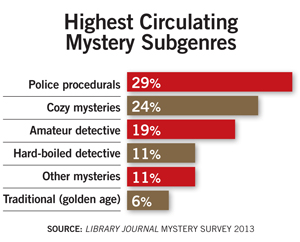 International noir, long dominated by Europeans, acquires an African flavor with the publication of South African Jassy Mackenzie’s latest Jade de Jonge title, Pale Horses (Soho Crime, Apr.) and Kenya-based Richard Crompton’s Hour of the Red God (Sarah Crichton: Farrar, Apr.), a debut thriller that introduces Maasai warrior–turned–detective Mollel who investigates the death of a prostitute on the mean, gritty streets of Nairobi.
International noir, long dominated by Europeans, acquires an African flavor with the publication of South African Jassy Mackenzie’s latest Jade de Jonge title, Pale Horses (Soho Crime, Apr.) and Kenya-based Richard Crompton’s Hour of the Red God (Sarah Crichton: Farrar, Apr.), a debut thriller that introduces Maasai warrior–turned–detective Mollel who investigates the death of a prostitute on the mean, gritty streets of Nairobi.
And of course for global crime fiction fans, there will always be an England. “It could be the S.J. Watson effect [author of the twisty best seller Before I Go to Sleep], but readers still can’t seem to get enough of the dark, deeply psychological novels coming out of the UK,” says Morrow associate editor Amanda Bergeron. She is especially excited about Cold Killing (Morrow, Jun.), a series launch by former London murder squad detective Luke Delaney. “This series taps into the dark side of London and a tense cat-and-mouse game leaving readers wondering who’s really in command—killer or hero—until the very end.”
Law & order
As the LJ survey found, police procedurals remain the highest circulating mystery subgenre in both print and ebook formats. But Tiffany Schofield, acquisitions editor for Gale Cengage’s Five Star imprint, is seeing many strong procedural entries that are genre-bending toward the thriller side. “Readers are perhaps enjoying their police procedurals more when they boast a fast-moving plot with breakneck pacing along with action and suspense,” says Schofield. A surprise 2013 Edgar Award nominee for Best Novel, Al Lamanda’s series debut, Sunset (Five Star, 2012), about an cop-turned-PI, was praised by reviewers as a “thrilling police procedural.” The sequel, Sunrise, will publish this July, and Schofield believes critics will agree that this gritty series just keeps getting better.
Also noticing a shift from the straightforward police procedural, Thomas & Mercer’s Bartlett points out that writers are now telling crime stories that are rooted in events on a much larger scale. “Terrorism, global economic and political crises, cultural conflicts—the questions today are bigger, and the new wave of thrillers addresses them.” Crediting Stieg Larsson’s “Millennium Trilogy” for paving the way for exploring stories within this larger context, Bartlett cites William Lashner’s The Accounting (May). “The elephant in the room is the global recession and how economic desperation leads to individual acts of crime.” And HarperCollins is hoping that the secrets of the Catholic Church remain a heady topic for police procedurals and thrillers; in June, its Harper imprint will publish Jonathan Holt’s The Abomination, the first entry in a new trilogy set in modern-day Venice, which brings together the Catholic Church, the CIA, and newly promoted Capt. Kat Tapo of the Carabinieri.
Yet great police procedurals continue to be written in the more traditional crime-solving style. “A completely gripping read,” says Bartlett, is Clyde Phillips’s Unthinkable (Thomas & Mercer, Aug.), which introduces married San Francisco homicide cops Jane Candiotti and her husband, Kenny Marks, as they grapple with bringing their child into the world while pursuing a mass murderer who killed Kenny’s nephew. This November, Colleen McCullough brings back Capt. Carmine Delmonico for his fifth outing in Sins of the Flesh (S. & S.) as his vacation is cut short by two killers on the loose. From Thomas & Mercer, Howard Kaminsky’s Angel Wings (Apr.) finds homicide detective Danny Martell pursuing a serial killer who attaches fabric angel wings to his victims. Not all cops patrol urban mean streets, however. In Joseph Heywood’s Hard Ground: Woods Cop Stories (Lyons, May), these game wardens may patrol Michigan’s wilds, but they see as much action as their urban counterparts in the form of poachers and drug pushers. And William Kent Krueger’s Minnesota sheriff–turned–PI Cork O’Connor returns to hunt for a judge’s missing wife in rural Tamarack County (Atria: S. & S., Aug.).
Digging deep
From Patricia Cornwell’s Kay Scarpetta to Kathy Reichs’s Temperance “Bones” Brennan, sleuths who solve crimes through the use of forensic science offer tantalizing glimpses into the world of the dead. “I think there’s perennial interest in all things forensic—dating back to the days of [television’s] Quincy, M.E.—and it really works in fiction,” notes William Morrow executive editor Lyssa Keusch. “There are different angles to be taken, between forensic art, archaeology, anthropology, and medicine among others. I think fans recognize this and keep coming back to devour the fascinating, and occasionally horrifying, details of this sometimes macabre science.”
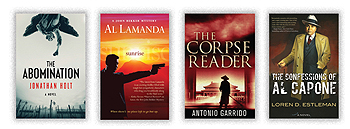 Keusch points to the best-selling success of “The Body Farm” forensic anthropology series published under the pseudonym Jefferson Bass (aka Dr. Bill Bass and Jon Jefferson). “Dr. Bill Bass is the real deal—a world-renowned forensic anthropologist from the University of Tennessee—and he brings a level of authenticity to the books that just can’t be beat.” Coming in September is Cut to the Bone (Morrow).
Keusch points to the best-selling success of “The Body Farm” forensic anthropology series published under the pseudonym Jefferson Bass (aka Dr. Bill Bass and Jon Jefferson). “Dr. Bill Bass is the real deal—a world-renowned forensic anthropologist from the University of Tennessee—and he brings a level of authenticity to the books that just can’t be beat.” Coming in September is Cut to the Bone (Morrow).
One of Five Star’s strongest series debuts of the year, Dead, Without a Stone To Tell It , by Jen J. Danna with Ann Vanderlaan (May), has homicide detective Leigh Abbott teaming up with forensic anthropologist Matt Lowell to identify a single bone and solve a murder. Inspired by the life of Song Ci (1127–1279 CE), considered the founder of “CSI-style forensic science,” is Antonio Garrido’s The Corpse Reader (AmazonCrossing, May), in which the elite “corpse reader” gets embroiled in a case that could take down the Chinese Emperor. This Zaragoza International Prize winner for 2012 Best Historical Novel in Spain has been translated into English for the first time. Also drawing on history is Matthew Guinn’s The Resurrectionist (Norton, Jul.), a fascinating debut about higher education, history, tradition, and secrets. When Jacob Thacker’s South Carolina school unearths the bones of dissected African American slaves, he will have to choose between continuing a cover-up or forcing the school to come clean about its past.
Famous people
Historical figures like Eleanor Roosevelt and Elizabeth I have their place in nonfiction, but new light can be shed on their personal history when they serve as protagonists in genre fiction. Ben Sevier of Guilt Edged Mysteries notes that crime stories “about living, breathing human beings seem to have returned to their central role in popular fiction.”
When Jane Austen died prematurely at the age of 41, questions were raised as to whether the author had suffered from arsenic poisoning. Drawing on letters and diaries from the Austen archive, mystery author Lindsay Ashford’s The Mysterious Death of Jane Austen (Sourcebooks Landmark, Aug.) re-creates the puzzle of Austen’s life and death. Keith Cameron makes the wife of Sherlock Holmes creator Arthur Conan Doyle the sleuthing protagonist in Winter at Death’s Hotel (Sourcebooks, Aug.) when the couple arrive in 1896 New York for Conan Doyle’s first U.S. author tour, and the murder of a hotel guest attracts Louisa’s attention.
Even philosopher/writer Henry David Thoreau, contemplating life at Walden Pond, turns sleuth in B.B. Oak’s Thoreau at Devil’s Perch (Kensington, Nov.), when the discovery of the body of a young black man disrupts the quiet. The infamous mobster Scarface gets his turn in the crime fiction spotlight in Loren D. Estleman’s The Confessions of Al Capone (Forge, Jun.).
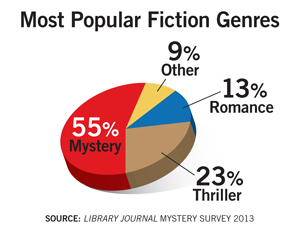 Cozies diversify
Cozies diversify
The cozy mystery continues to expand beyond its Agatha Christie roots to encompass a range of subgenres that spin humor, intrigue, and sometimes a few recipes or crafts into their pages. Cozies rarely experiment, explains Minotaur publicist Justin Velella, but one new wry writer to the scene is G.M. Malliet. “Her new(ish) series starring Max Tudor, vicar in a small English village and former MI5 agent, does something new and ingenious: it is both a love letter and a send-up of the traditional English mystery, and fans can’t get enough.” Max’s next adventure, Pagan Spring, hits library and bookstore shelves this October.
Food remains a focus for cozies. Caterer Goldy Schultz solves another delectable crime in Dianne Mott Davidson’s The Whole Enchilada ( Morrow, Aug.), while a young woman seeks refuge at her aunt’s pie shop after she is framed for embezzlement by her boss in Ellie Grant’s Plum Deadly (Gallery: S. & S., Sept.). Consumer interest in health and well-being is giving life to gardening cozies, particularly those with an organic theme. Says Five Star’s Schofield, “Readers can enjoy a good mystery while learning about organic farming or gardening, even if they reside in an urban area.” Urban farming has its day in Judy Dailey’s series debut Animal, Vegetable, Murder (Five Star, Apr.).
Aging baby boomers who enjoy mysteries that feature physically flawed sleuths are driving the growing “Geezer Lit” trend, and Schofield credits Mike Befeler’s series featuring octogenarian sleuth Paul Jacobson for kicking this niche subgenre into high gear. In the fifth entry, Care Homes Are Murder (Five Star, Jun.), Jacobson, on a family vacation in Hawaii, becomes involved in a series of crimes while struggling with problems caused by his short-term-memory loss.
The digital-print connection
As more talented new authors take the digital route, mystery readers increasingly enjoy the ease and convenience of finding new voices through ereader read-alike suggestions at prices attractive enough to lure them to test unfamiliar reading waters. Buying a digital book does not spell the demise of the print edition, according to Five Star’s Schofield. “We have heard from many mystery genre fans that when they do fall in love with a series and/or author through ereader discovery, they are much more likely to go and buy that author’s backlist and frontlist print books to keep on their favorites shelf.”
Mystery LineupBelow are the forthcoming titles mentioned in this article
Author Title Publisher Release Amore, Dani The Circuit Rider Thomas & Mercer Feb. Ashford, Lindsay The Mysterious Death of Jane Austen Sourcebooks Landmark Aug. Bass, Jefferson Cut to the Bone Morrow Sept. Befeler, Mike Care Homes Are Murder Five Star: Gale Cengage Jun. Brown, Fredric We All Killed Grandma Guilt Edged Mysteries Jul. Cameron, Keith Winter at Death’s Hotel Sourcebooks Landmark Aug. Crompton, Richard Hour of the Red God Sarah Crichton: Farrar Apr. Dailey, Judy Animal, Vegetable, Murder Five Star: Gale Cengage Apr. Danna, Jen J. with Ann Vanderlaan Dead, Without a Stone to Tell It Five Star: Gale Cengage May. Davidson, Diane MottThe Whole Enchilada Morrow Aug. de la Motte, Anders Game Atria: S. & S. Jul. Delaney, Luke Cold Killing Morrow Jun. Estleman, Loren D. The Confessions of Al Capone Forge: Tor Jun. Florio, Gwen Montana Permanent Oct. Garrido, Antonio The Corpse Reader AmazonCrossing May. Grant, Ellie Plum Deadly Gallery: S. & S. Sept. Guinn, Matthew The Resurrectionist Norton Jul. Hammer, Lotte & Søren Hammer The Hanging Minotaur: St. Martin’s Jun. Harrington, Jean Killer Kitchens Carina (ebook) Apr. Heywood, Joseph Hard Ground: Woods Cop Stories Lyons May. Holt, Jonathan The Abomination Harper: HarperCollins Jun. Jansson, Anna Strange Bird Stockholm Text (ebook/print) Sept. Jensen, Martin The King’s Hounds Thomas & Mercer Oct. Jungstedt, Mari Killer’s Art Stockholm Text (ebook/print) Feb., Oct. Kaminsky, Howard Angel Wings Thomas & Mercer Apr. Kepler, Lars The Fire Witness Sarah Crichton: Farrar Jul. Krueger, William Kent Tamarack County Atria: S. & S. Aug. Lamanda, Al Sunrise Five Star: Gale Cengage Jul. Lashner, William The Accounting Thomas & Mercer May McCullough, Colleen Sins of the Flesh S. & S. Nov. Mackenzie, Jassy Pale Horses Soho Crime Apr. Malliet, G.M. Pagan Spring Minotaur: St. Martin’s Oct. Nakamura, Fuminori Evil and the Mask Soho Crime Jun. Neuhaus, Nele Swimming with Sharks Thomas & Mercer Jun. Oak, B.B. Thoreau at Devil’s Perch Kensington Nov. Peterson, Andrew Option To Kill Thomas & Mercer Jan. Phillips, Clyde Unthinkable Thomas & Mercer Aug. Pochoda, Ivy Visitation Street Dennis Lehane: HarperCollins Jul. Rosen, Leonard The Tenth Witness Permanent Sept. Steinberg, Hank Out of Range Morrow Jun. Tuomainen, Antii The Healer Holt May Widen, Gregory Blood Makes Noise Thomas & Mercer Apr. Williams, Timothy Another Son Soho Crime Apr. Wong, S.G. Die on Your Feet Carina May.
Kristi Chadwick is Director, Emily Williston Memorial Library, Easthampton, MA. Chadwick is an LJ reviewer and can be found talking ebooks and collection development on Twitter (@booksnyarn)
Add Comment :-
RELATED
ALREADY A SUBSCRIBER? LOG IN
We are currently offering this content for free. Sign up now to activate your personal profile, where you can save articles for future viewing








